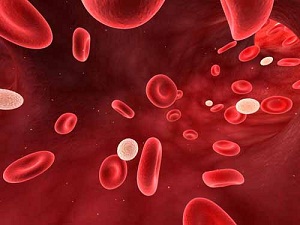



Polycythaemia is the medical name for the excess of red blood cells (red blood cells) in our circulatory system. Red blood cells, or erythrocytes, are the most common type of blood cell, and our organism’s principal mean of delivering oxygen to body tissues. There is no established threshold for high red blood cell count, however, as it greatly differs from one place to another. Despite this, 5.72 million red blood cells per microliter for men, or 5.03 for womenis generally regarded as a high red blood cell density.
Polycythaemia or the excess of red blood cells comes with a series of symptoms that will warn you about it. Note symptoms will probably not become patent in mild cases. Common symptoms include:
High blood pressure is probably the main symptom, although obviously not one you can feel directly.
As you can see, Polycythaemia’s symptoms are quite unpleasant. However, most would probably not consider them to be dangerous.We will now discuss potential aggravations and bigger problems arising from having too many red blood cells, showing it might actually be more serious than that.
Polycythaemia has got linked with liver and kidney cancer in some cases. That’s a proof of how serious it can get. High red blood cells density in your blood increases blood pressure and this can be associated with deep vein thrombosis (DVT) too, but also with strokes, heart attacks and embolism, all of which may lead to death. Blood cancer or leukemia is considered another potential outcome of polycythaemia, maybe the worst one. Internal hemorrhages and excessive bleeding has also been linked to it.
After multiple studies and research, we have come to know what causes excessive quantities of red blood cells to originate, and so we can also treat it. Yet there is not a single cause of polycythaemia, and each cause is based on the type of polycythaemia you suffer from. Below, we have discussed causes of too many red blood cells according to the different types.
Primary polycythaemia is a kind of excess in red blood cells caused by an excessive productiondue to inherent or acquired problems. It’s further on divided into 2 subcategories as:
The difference with secondary polycythaemia, on the other hand, is that this one occurs as a response to other underlying condition(s) that cause an excess in the production of red blood cells.
Secondary polycythaemia is generally due to high levels of erythropoietin, the hormone that regulates the production of red blood cells in the bone marrow. Rising in erythropoietin levels is a response to either of the following conditions:
|
Chronic Hypoxia |
Tumors |
|
Hypoxemia or hypoxia is an abnormally low level of oxygen in the blood. It can take place for several reasons. The most common ones are: Chronic Obstructive Pulmonary Disease (COPD) Pulmonary hypertension Heart diseases Sleep apnea Note: certain people are more likely to have lower or higher levels of oxygen in the bloodstream. Sportsmen, for instance, present levels way above the average, while people living in high altitudes present the opposite. |
There are tumors that affect our organism in such a way our levels of erythropoietin rise, which then increases the production of red blood cells. The most common of these tumors are: Liver cancer Kidney cancer Uterine tumors Adrenal adenoma Note: Benign tumors or cysts can sometimes cause EPO levels to rise too, but it’s not always and definitely cancer, something many are thankful for. |
Fortunately, numerous scientists have developed a number of effective methods in order to cope and even counter arrest the negative effects of having too many red blood cells. Here are some treatments for too many red blood cells:
There are several different treatments you can indulge in, depending on the cause and type of polycythaemia you suffer from. One of them is as simple as sporadically removing blood (phlebotomy).
Besides, here are two main medications you can use when having too many red blood cells:
People with primary polycythemia can engage in a series of simple domestic treatments that will allow them to keep the symptoms within certain acceptable boundaries. Most of these treatments do not require any sort of prior knowledge or treating skills. Here are some simple ones you can try: